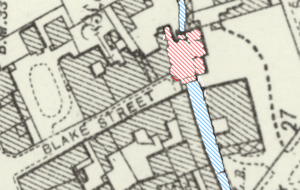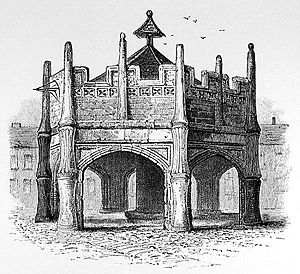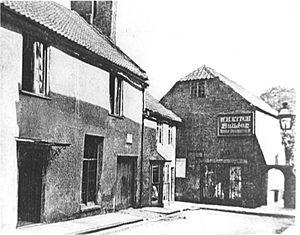Bridgwater Town Mill facts for kids
The Bridgwater Town Mill is an old building in Bridgwater, England. It sits at the end of Blake Street, right next to the Blake Museum. This mill used water from the Durleigh Brook, which flows into the River Parrett. For many years, it was known as the Lytel Mill and was used to grind corn for the town. It is a very old and important building, officially recognized as a Grade II listed building.
Contents
Early History of the Mill
The Bridgwater Town Mill has a long history. It was first mentioned way back in 1086 in the Domesday Book. This book was like a big survey of England, and it listed the mill as one of the town's valuable resources. At that time, it was worth five shillings.
The mill also appeared in various official documents from Bridgwater between 1361 and 1380. It was mentioned again in 1413, showing it was an important part of the town for centuries.
Royal Rules for the Mill
In 1587, Queen Elizabeth I issued a special royal document for Bridgwater. This document, called a royal charter, included rules about the mill. It said that people in Bridgwater could only sell ale or beer if they ground their corn and malt at the Little Mills (which was the Town Mill). This rule made sure the mill was always busy and important to the town's economy.
From Grinding Corn to Pumping Water
In 1694, the mill changed its job. Instead of grinding corn, it was changed to pump water. It would pump water from the Durleigh Brook to a large tank under the town's High Cross. From there, people called hawkers would carry water to homes around the town.
To make this work, pipes made from hollowed-out elm trees were put under the streets. Many of these old wooden pipes have been found during road repairs over the years. Richard Lowbridge, an iron seller, and Daniel Dunnett, a carpenter, were in charge of this project. They also set up similar water systems in other towns like Exeter and Barnstaple.
The High Cross was taken down around 1800. After that, Bridgwater did not have a proper town-wide water supply until the 1870s. That is when the town council built the Ashford Waterworks.
Changes in the 1800s
The mill was put up for sale in April 1804. At that time, it had a large water wheel, about 15 feet across. Not much is known about the exact machines used inside. However, some old gears from the 1800s show that the millstones were on the upper floor.
During the 1800s, the mill continued to grind corn. In 1858, it was updated to use steam power. A new part was built onto the mill to hold the steam engine, boiler, and its chimney. Around 1860, an advertisement for renting the mill mentioned it had a 10-horsepower steam engine and three sets of millstones.
Soon after, the mill became a saw mill, cutting wood. By the end of the 1800s, it was no longer used for milling. A builder then used the space. This builder was also the town's inspector for weights and measures.
Later Uses of the Mill
From about 1920 to 1940, a company that made wicker furniture used the mill building. Making wicker furniture was a big business in the area back then. After that, another local builder used the mill. During the Second World War, it became a place for Civil Defence to store and give out supplies.
Fire and Restoration Efforts
In 1987, the mill was put up for sale again. The Bridgwater Museum Development Trust bought it. They planned to make it part of the Blake Museum. An archaeological study was done, and plans were made to fix up the mill.
However, before the restoration work could begin, a fire badly damaged the mill in June 1995. Most of the roof and the upper floor of the main mill were destroyed. Part of the Blake Museum's roof was also damaged. Some valuable paintings by John Chubb got smoke damage and needed special cleaning.
After the fire, Sedgemoor District Council bought the mill. For safety, the council lowered the damaged upper walls, leaving them standing up to the first-floor level. In 2009, the museum was given to the Bridgwater Town Council. Volunteers now manage the museum.
The volunteers cleared out the rubble from inside the mill. They also fixed the roof of the part that was still standing. This space is now used to store old items found during archaeological digs. Later, a wooden floor was put in over the cellar area of the main mill. This made it easier to get into the building from the street.
In 2017, the Bridgwater Town Council approved a project to fully restore the main mill. This includes rebuilding its original shape and bringing back the water wheel. Designs and cost estimates for this work are being prepared. The Friends of Blake Museum group is organizing the project. When finished, the restored mill will be a great addition to the museum and the town.





